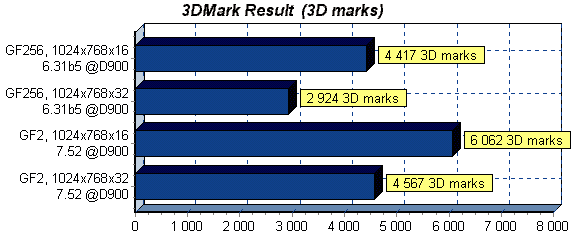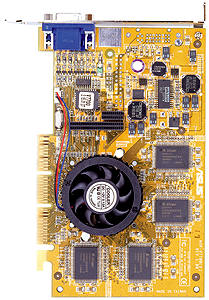Copyright
1996-2025
by TSW
(Nikolay Tuzhilin)
Last updated: 22.01.2025
General information
This videocard produced by Asustek Inc. is based on the modern and fast graphic chip (Feb`2001) GeForce2 GTS (GF2) designed by nVIDIA.
As the speed of new 3D accelerators increases also increases the 2D display quality. And if on Asus 6600 the resolution 1280x1024 is just acceptable (on 19" monitor), on Asus 7700 it is already perfectly sharp.
Need For Speed 5 with driver 6.67 at 1024x768x32 mode gives 35-45 fps by Fraps at Duron 900 CPU and at 1024x768x16 gives 45-65 fps. Although this is not much faster then results on plain GF256 (27-34/35-45) they at least allow you to safely switch to true color and loose no speed.
GeForce2 GTS chip made by more superior technology then GeForce256, so it consumes less power, hence it must be cooler. At idle mode my Asus 7700 warms up to 47-51°C while Asus 6600 keeps about 65°C.
3DMark 2000
3D benchmark of GF2 GTS results measured by MadOnion 3D Mark 2000 1.1 compared with GF256:

| Rendering Platform | nVIDIA GeForce256 | nVIDIA GeForce256 | nVIDIA GeForce2 GTS | nVIDIA GeForce2 GTS | |
| Resolution | 1024*768 | 1024*768 | 1024*768 | 1024*768 | |
| Color Depth | 16-bit Color | 32-bit Color | 16-bit Color | 32-bit Color | |
| Texture Format | 16-bit | 32-bit | 16-bit | 32-bit | |
| Z-Buffer Depth | 16-bit | 24-bit | 16-bit | 24-bit | |
| CPU Optimization | D3D Hardware T&L | D3D Hardware T&L | D3D Hardware T&L | D3D Hardware T&L | |
| 3DMark Result | 4417,12 | 2923,68 | 6061,86 | 4567,4 | 3D marks |
| Game 1 - Helicopter - Low Detail | 92,41 | 56,02 | 121,41 | 92,68 | FPS |
| Game 1 - Helicopter - Medium Detail | 65,16 | 41,39 | 89,14 | 66,89 | FPS |
| Game 1 - Helicopter - High Detail | 31,33 | 20,94 | 46,33 | 32,33 | FPS |
| Game 2 - Adventure - Low Detail | 79,84 | 48,38 | 138,4 | 86,75 | FPS |
| Game 2 - Adventure - Medium Detail | 60,29 | 44,03 | 68,67 | 62,14 | FPS |
| Game 2 - Adventure - High Detail | 39,07 | 32,88 | 41,21 | 39,83 | FPS |
| Fill Rate (Single-Texturing) | 297,59 | 135,78 | 546,07 | 256,44 | MTexels/s |
| Fill Rate (Multi-Texturing) | 477,17 | 283,96 | 1117,69 | 526,52 | MTexels/s |
| High Polygon Count (1 Light) | 10701,22 | 8096,47 | 12985,32 | 11612,01 | KTriangles/s |
| High Polygon Count (4 Lights) | 6117,02 | 5372,11 | 9722,58 | 8635,91 | KTriangles/s |
| High Polygon Count (8 Lights) | 3358,22 | 3173,25 | 5443,91 | 5178,66 | KTriangles/s |
| 8MB Texture Rendering Speed | 231,95 | 117,55 | 394,37 | 212,69 | FPS |
| 16MB Texture Rendering Speed | 218,3 | 113,2 | 299,03 | 203,69 | FPS |
| 32MB Texture Rendering Speed | 171,2 | 108,1 | 170,49 | 178,2 | FPS |
Test configuration: AMD Duron 900MHz (overclocked from 700) CPU, Asus A7V (VIA KT133 based) motherboard and 256MB PC100 (tCAS=2) SDRAM memory, Fujitsu MPD3130 hard drive, OS Microsoft Windows ME.
CPU upgrade benchmark
After upgrade of CPU from AMD Duron 900 by AMD Athlon 2100+ (266MHz*13) the general speed of video system is increased:
| Platform | NVIDIA GeForce2 GTS/GeForce2 Pro | NVIDIA GeForce2 GTS/GeForce2 Pro |
| CPU Optimization | D3D Hardware T&L | D3D Hardware T&L |
| Width | 1024 | 1024 |
| Height | 768 | 768 |
| Depth | 32 bit | 32 bit |
| Z-Buffering | 24 bit | 24 bit |
| Texture Format | Compressed | Compressed |
| Buffering | Double | Double |
| FSAA Mode | None | None |
| 3DMark Score | 2986 | 4149 |
| Game 1 - Car Chase - Low Detail | 56.2 fps | 64.1 fps |
| Game 1 - Car Chase - High Detail | 16.4 fps | 33.9 fps |
| Game 2 - Dragothic - Low Detail | 54.2 fps | 71.5 fps |
| Game 2 - Dragothic - High Detail | 25.3 fps | 34.0 fps |
| Game 3 - Lobby - Low Detail | 53.6 fps | 68.4 fps |
| Game 3 - Lobby - High Detail | 25.6 fps | 37.6 fps |
| Game 4 - Nature | Not supported by hardware | Not supported by hardware |
| Fill Rate (Single-Texturing) | 230.3 MTexels/s | 252.4 MTexels/s |
| Fill Rate (Multi-Texturing) | 449.9 MTexels/s | 475.9 MTexels/s |
| High Polygon Count (1 Light) | 17.3 MTriangles/s | 23.0 MTriangles/s |
| High Polygon Count (8 Lights) | 4.7 MTriangles/s | 4.8 MTriangles/s |
| Environment Bump Mapping | Not supported by hardware | Not supported by hardware |
| DOT3 Bump Mapping | 36.8 fps | 37.8 fps |
| Vertex Shader | 28.0 fps | 49.4 fps |
| Pixel Shader | Not supported by hardware | Not supported by hardware |
| Advanced Pixel Shader | Not supported by hardware | Not supported by hardware |
| Point Sprites | 6.5 MSprites/s | 7.3 MSprites/s |
So, in case of this card, we see average increase on all characteristics (except fill rate of cause, that depends on video memory speed and quantity of conveyers on GPU only), and the most CPU dependant is vertex shaders and geometry engine in case of low lights number.
Specifications
The following information taken from the official page.
 |
AGP-7700 GeForce2 GTS Pure specifications |
|
Graphics engine |
|
|
Video Memory |
|
|
RAMDAC Integrated 350MHz RAMDAC supporting from 640x480 up to 2048x1536 in true color |
|
|
T&L Engine |
|
|
Maximum Polygons |
|
|
OpenGL |
|
|
Multi-Buffering |
|
|
Vertical refresh rate |
|
|
Bus standard |
|
|
Multiple Video Windows |
|
|
Optimized for 3D Acceleration |